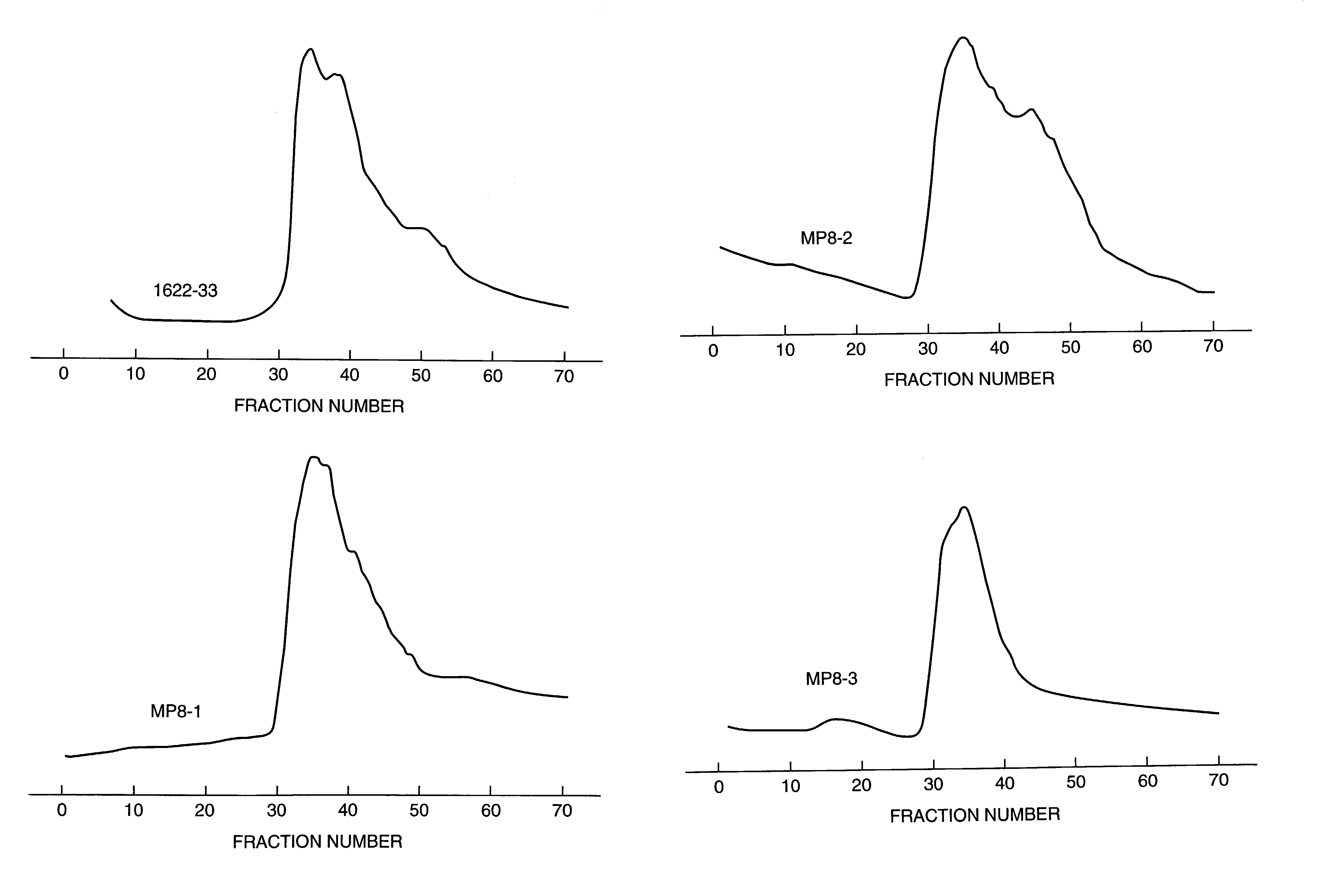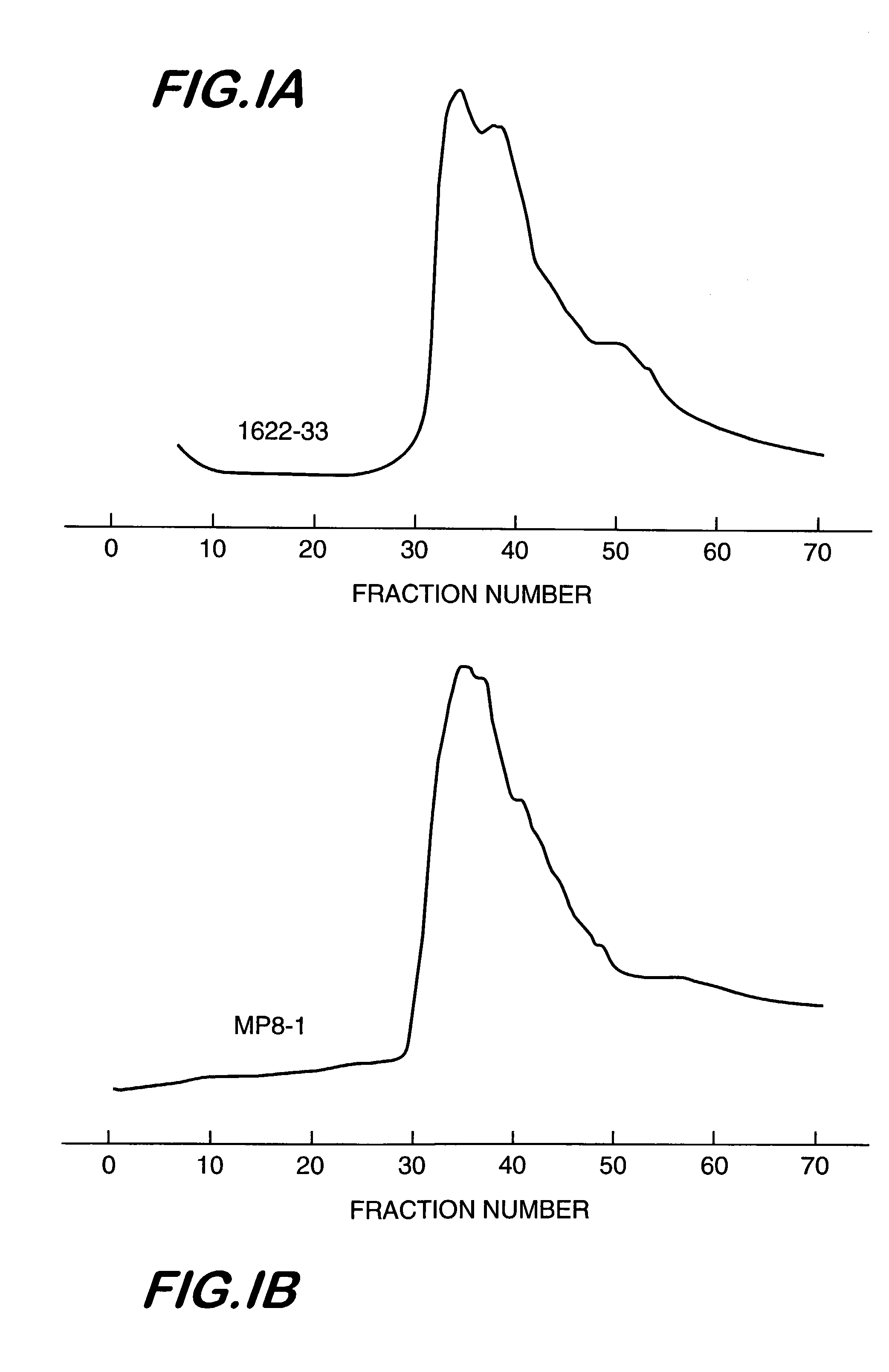Aminodextran compositions and conjugates and method of making and using them
a technology of aminodextran and composition, applied in the field of aminodextran compositions and conjugates and the method of making and using them, can solve the problems of inconvenient labeling, inconsistent yield and amplification, and less efficient labeling for diagnostic procedures
- Summary
- Abstract
- Description
- Claims
- Application Information
AI Technical Summary
Benefits of technology
Problems solved by technology
Method used
Image
Examples
example 1
Preparation of High Molecular Weight Improved Aminodextran
A. Production of Aminodextran
[0050]Several lots of heterogeneous mixtures of aminodextrans of nominal molecular weight, 2M Da, were obtained from Molecular Probes, Inc. (MP8, MP8-2 and MP8-3). Additionally, the inventors produced their own aminodextran preparations, lot 9–85, and lots 1622–29 and 1622–33, using dextran of nominal molecular weight, 2M Da, supplied by Sigma and Pharmacia, respectively. The production process was as follows:
[0051]11.6 g chloroacetic acid, sodium salt is dissolved in 100 ml water, added to a solution of 11.2 g dextran with a MW of 2 MDa in 36 ml 1 M NaOH and stirred for 20 hours at 40° C. Afterwards the pH is adjusted to a value of 4 with 1M HCl and concentrated to a volume of 50 ml on a rotary evaporator. The carboxymethyldextran which forms is dissolved in 50 ml 2M ethylenediamine dihydrochloride, pH 5 and 3 g N-ethyl-N′(3-dimethylaminopropyl)carbodiimide monohydrochloride is added in portions ...
example 2
Triple Detector Results for High Molecular Weight Aminodextrans
[0056]The commercial heterogeneous mixtures of aminodextran identified above were sent for measurement of weight-average molecular weight, intrinsic viscosity, and refractive index in aqueous media to a commercial company, i.e., Viscotek, Inc. Also, the purified aminodextrans from lots MP8 and 1622–33, chromatographed on Sepharose 4B and selecting the high molecular weight fractions for subsequent lyophilization, as described in Example 1 were also subjected to the same triple detector measurements. The data are summarized in Table 1.
[0057]
TABLE 1Triple Detector System Data for Aminodextran CompositionsLot No.Mw, kDaLog(Mw)IVw, dL / gLog(IVw)Rg, nmLog(Rg)MP82,7346.4370.774−0.11145.751.6609-852,3316.3670.710−0.14942.151.6251622-293,137.56.4960.796−0.099148.371.684MP8-22,1766.3380.656−0.18340.121.6031622-333,9116.5920.782−0.10751.751.714MP8, purif7,9996.9030.939−0.027369.631.8431622-33, purif6,8876.8380.867−0.062064.501.809M...
example 3
Dynamic Light Scattering Results for High Molecular Weight Aminodextrans
[0060]Quasi-elastic light scattering (QELS) measurements were performed on dilute (˜1 mg / mL), buffered (1×PBS) solutions of the sulfo-SMCC derivatives of aminodextrans (MP8, MP8-2, and MP8-3) before and after purification with the COULTER® Model N4MD sub-micron particle analyzer. The sulfo-SMCC derivatives were measured since these are the molecular species present in solution immediately before conjugation with the activated proteins. Also, they are neutral in aqueous solution unlike the positively-charged aminodextrans in 1×PBS at pH 7.2–7.3. Results of unimodal analyses at a 90° scattering angle, including average mean hydrodynamic diameter, inter-assay standard deviation (SD), and polydispersity index are displayed in Table 2.
[0061]
TABLE 2Dynamic light scattering data for various sulfo-SMCC-aminodextransAverage meanSulfo-SMCChydrodynamicInter-assay SD,Polydispersityderivativediameter, nmnmindexMP81042.40.40M...
PUM
| Property | Measurement | Unit |
|---|---|---|
| MW | aaaaa | aaaaa |
| hydrodynamic diameter | aaaaa | aaaaa |
| concentration | aaaaa | aaaaa |
Abstract
Description
Claims
Application Information
 Login to View More
Login to View More - R&D
- Intellectual Property
- Life Sciences
- Materials
- Tech Scout
- Unparalleled Data Quality
- Higher Quality Content
- 60% Fewer Hallucinations
Browse by: Latest US Patents, China's latest patents, Technical Efficacy Thesaurus, Application Domain, Technology Topic, Popular Technical Reports.
© 2025 PatSnap. All rights reserved.Legal|Privacy policy|Modern Slavery Act Transparency Statement|Sitemap|About US| Contact US: help@patsnap.com



